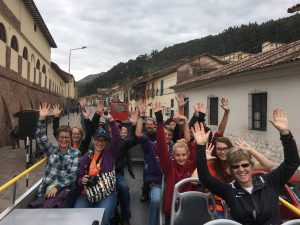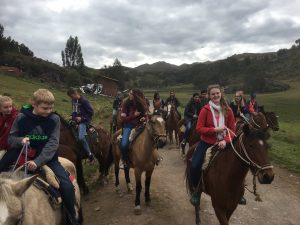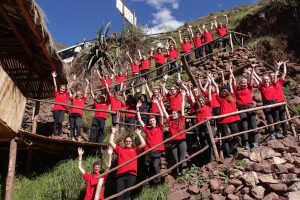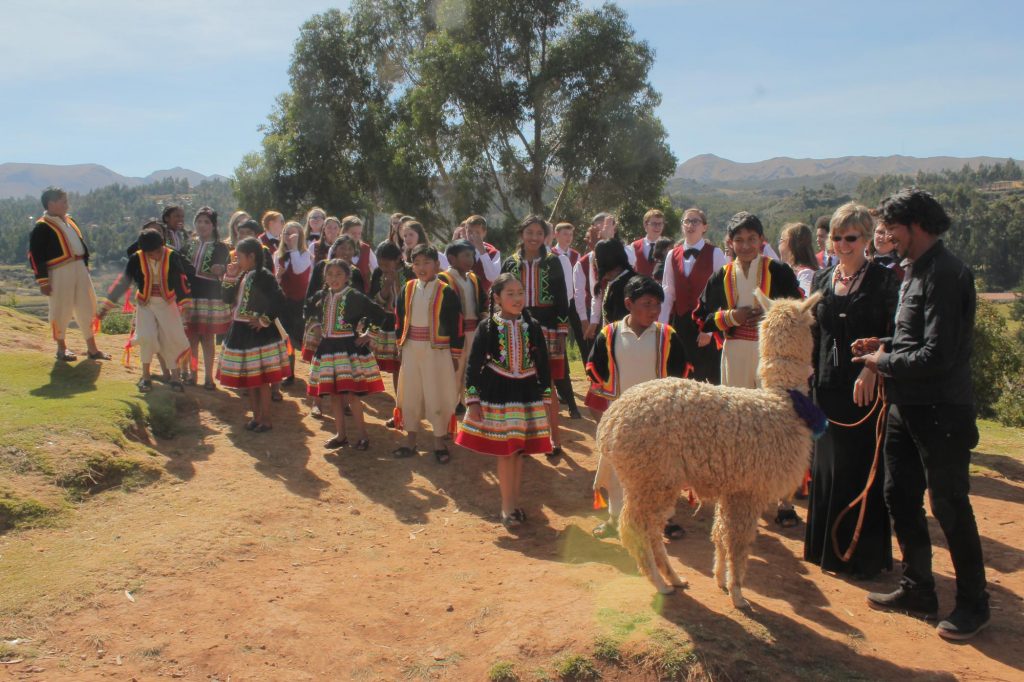Nice alpaca? Ernesto. Mean, spitting alpaca? Pancho. Ice cream? “Best ever.” Hamburger? “Peculiar-tasting.” Dogs? 1,186. Cats? “About 4.”
Humor, food notes, marvel and occasional touches of homesickness thread the reflections by choristers among the 27 members of the Shenandoah Valley Children’s Choir (SVCC) who spent two weeks this summer in Cusco, Peru, in part to collaborate with a Peruvian children’s choir to record and film a music video for release this fall. SVCC is a program of Eastern Mennonite University.
“We’re not going there to show how good we are,” artistic and executive director Janet Hostetter told the choristers before the trip. “We’re going down there to experience another culture and to embrace it and to learn from it.”
Moments

Choristers visited Machu Picchu and two Mennonite churches, performed numerous times, including in a Catholic mass, a school concert and two city squares, learned about Andean music and traditional dance, soaked up Peruvian culture, and more.
Only two days into the trip, a chorister sustained a leg injury requiring stitches. Fortunately a chaperone who is also a physician had brought along medical supplies and stitched the wound — on a kitchen table in a dining area.
On another day, wrote Emily Reichard in one of the daily Facebook posts by various choristers, the group “visited a local children’s school, Promesa, where we sang and read with students. I enjoyed reading a Thomas the Tank Engine book to a sweet little boy — even though he was more interested in playing Spanish Bingo with his friends.”
Skylar Wampler recalled “singing in a Spanish church service that was so beautiful I cried not once, but twice,” and “washing every white SVCC shirt by hand with three others in Mrs. Hostetter’s bathtub and hanging them to dry on a makeshift clothesline in the empty swimming pool.”
John Byrd wrote that the trip “definitely pulled me out of the perspective of a teenage boy living in Virginia. I think I owe that to the mostly cold showers and eating bread almost religiously every morning.”
Intern Ben Luna lost his glasses out an open train window. “Luckily another chorister had a pair of spare glasses with a similar prescription in one eye,” wrote MacRae Richardson. “The other eye was not the same, however. To solve the problem, Ben covered the one eye with his drink coaster. Thus, Ben looks like a pirate with girls’ glasses and an ‘Inca Rail’ eye patch.”
Machu Picchu left Afton Rhodes-Lehman in “pure shock. I was already expecting beauty but the scenery blew me away. The air was cool and fresh, and the mountains that surrounded me baffled me with their majesty and grandeur. Their peaks were hidden by fog and clouds, which made it feel like they had pierced the dome of the sky.”

More than halfway into the trip, the group divided for an afternoon of either horseback riding or shopping. “I don’t think my horse liked me because I was too big for it,” wrote Jonathan Murch. “At one point during the ride, Mr. Horse got its tail stuck in some barbed wire; so, I dismounted and detangled its tail and then Mr. Horse ran off. This was unfortunate because I paid a decent amount of money to ride him. In the end, I got him back and had a grand ole’ time.”
As the end of the trip neared, Helene Holzer said, “Peru has been one of the greatest experiences of my life,” and Josiah Ropp reflected that the choristers “have all become closer and gotten to know each other better … even if there were a few bumps in the road. I am sad to say that this trip is almost up but glad that I will be able to get up and take a shower whenever I want.”
Caroline Dean began the final post with, “Sunday was sadly our last [full] day in Cusco, but it definitely wasn’t sad!” and recounts the feeling of welcome in the church where the choir sang that day, meeting the trip’s 1,142nd dog (she reports seeing 43 more on the way back to the hostel, and one more on the way to the airport the next day), and procrastinating with roommates before packing up to leave for home.
“This was an amazing experience,” she wrote, adding that the memories are ones “that we will hold close to us for the rest of our lives.”
‘Most difficult but most satisfying’
Not everything on the trip went as planned, of course. But what did happen was reciprocity, said Hostetter, perhaps most notably with Los k’ana Wawakuna, a Peruvian children’s choir directed by Amilcar Soto.

Soto, whose passion for Peruvian culture is evident in the sound and look of his choir, wrote a song in Spanish and Quechua for Los k’ana Wawakuna and SVCC to record and sing in a music video. The video will show both choirs singing the song on a hilltop that on one side overlooks Cusco. The view from the other side, though, where the SVCC choristers begin in the video, looks like it could be the Shenandoah Valley.
“Originally we were going to have Los k’ana Wawakuna run to join the SVCC choristers, but realized that would misrepresent the idea of collaboration,” Hostetter said. “So instead, we had everyone run to the middle, to become a new choir.”
“Flexibility” became Hostetter’s mantra throughout the project: The five planned days devoted to the project ended up being reduced to one day — which then turned into three partial days. She unexpectedly needed to entertain the children of Los k’ana Wawakuna on the first night they arrived in Cusco because Soto could not come until the next day. Then, because Soto teaches his choir without written music and so had provided none to SVCC, Hostetter resorted to writing the lyrics in large handwriting on a legal pad, which she held up for the singers to read. And with the project unexpectedly in development even as it was underway, Hostetter had to figure out how to translate portions of the song into English text that would fit both rhythmically and thematically — as late as on the bus ride to the studio on the day of recording.
Then, in the studio, a chorister who felt sick came to SVCC intern Ben Luna, who at the moment was holding the legal pad of lyrics and translations. Luna and the chorister left quickly for a restroom down the street, in their hurry taking along the legal pad, unintentionally bringing the recording session to a standstill.
In short, it was more than just a couple times that Hostetter wasn’t sure the project would come together.
Even so, by the last day of collaboration she described a spirit of “total trust”: things had worked out. That final day, when the door of the bus bringing the Los k’ana Wawakuna choristers opened and released the flood of children to the filming site, “the joy was palpable,” she said, with “love and hugs.”
Los k’ana Wawakuna parents, too, showed warmth to Hostetter and the SVCC choristers at the film site. When the lady with the alpaca (the mean one, Pancho) insisted on overcharging Hostetter for its appearance in the video, those parents stepped in and admonished the lady, “No! Don’t do this to them!”
“They were looking out for us,” Hostetter said. “We were friends.”
Soto and parents of Los k’ana Wawakuna went on to invite SVCC to pray with them, which Hostetter said was a “moving” time.
The project was “by far the most difficult thing to line up, but the most satisfying,” said Hostetter’s daughter Brook, who, having lived for two years in Cusco as an Eastern Mennonite Missions and Virginia Mennonite Missions worker, facilitated the SVCC trip.
Doctoral research

For SVCC director Hostetter, the trip had an additional layer: thesis research discovering the pedagogical practices of choirs of national or international renown for her anticipated doctorate of musical arts from James Madison University.
Los k’ana Wawakuna was the first of five choirs that Hostetter will compare and contrast, along with Jitro in the Czech Republic, Hail Mary the Queen Children’s Choir in the Philippines, Drakensberg Boys Choir in South Africa, and The Australian Children’s Choir.
Amilcar Soto’s Los k’ana Wawakuna, Hostetter thinks, is a bright spot because of its ardent preservation and presentation of Peruvian culture and ways of teaching music.
“It was very different from our traditions, but I found it so valuable,” said Hostetter, a 1987 graduate of EMU. “Soto has kept the Peruvian culture so passionately steeped in what they do, and it begged me to ask the question, ‘How would I, as the director of the Shenandoah Valley Children’s Choir, passionately produce music of this region with the choir like he does?’ I’m not sure that I can, in part because we are not one uniform culture. We are a melting pot.”
An overcome barrier
The language barrier that SVCC faced in Peru was real, Hostetter reflects, but it didn’t keep the choristers from dubbing their hostel cooks “wonderful ladies” or stifle the enthusiasm for the clapping games played together by SVCC and Los k’ana Wawakuna choir members.
And Hostetter remembers the heartfelt thanks offered to her after SVCC sang in a church service, when a four-feet tall lady grabbed her around the neck and held tight, exclaiming again and again, “Gracias, mama! Gracias mama!”
That was an embrace.

What an awesome learning experience for the choir. Cross-cultural sharing in song — an enriching lesson in learning to appreciate and value other expressions of joy. Kudos to SVCC.
Wow! This is wonderful – the world needs more of this and I look forward to the video. I’ve been a fan of this choir for years.